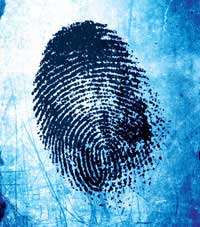| Posted: March 12, 2007 |
Nanotechnology reveals fingerprints |
|
(Nanowerk News) Hidden fingerprints can now be revealed quickly and reliably thanks to two developments in nanotechnology.
|
|
The current way of revealing hidden prints involves coating the marked surface with a watery suspension of gold nanoparticles, stabilised by citrate ions. Under acid conditions, the gold particles stick to the positively-charged molecules in the fingerprint. The print is then developed with a solution of silver ions, which undergo a chemical reaction to leave an outline of dark silver metal along the characteristic ridges of the fingerprint. But the gold solution is quite unstable, and the technique is difficult to reproduce from one test to another.
|
 |
|
Now, Daniel Mandler, Joseph Almog and co-workers at The Hebrew University of Jerusalem, Israel, have replaced the traditional gold solution with a more stable equivalent. Their gold nanoparticles bristle with long hydrocarbon chains and are suspended in petrol ether. They stick to the fingerprint residues through hydrophobic interactions, and can be developed with silver as before, producing high quality prints after just three minutes immersion time ("Application of nanoparticles for the enhancement of latent fingerprints" – free access article).
|
|
The team has also developed a fingerprinting method for non-porous surfaces, using a petrol ether suspension of cadmium selenide/zinc sulphide nanoparticles stabilised by long chain amines. As with the team's gold solution, the nanoparticles adhere to the fingerprint by hydrophobic interactions. But in this case, as the nanoparticles fluoresce under UV light to reveal clear fluorescent prints, no additional developing stage is needed.
|
|
Claude Roux, director of the Centre for Forensic Science at the University of Technology, Sydney, Australia, said that the use of 'nanotechnology in the fingerprint community...can bring novel and practical solutions to develop and enhance latent fingermarks...that would otherwise remain un-detected.'
|
|
This view was confirmed by Antonio Cantu, an expert in forensic science for the United States Secret Service in Washington, who described the techniques as 'revolutionary' and said they 'are apt to greatly improve the recovery of latent prints on evidence'.
|

